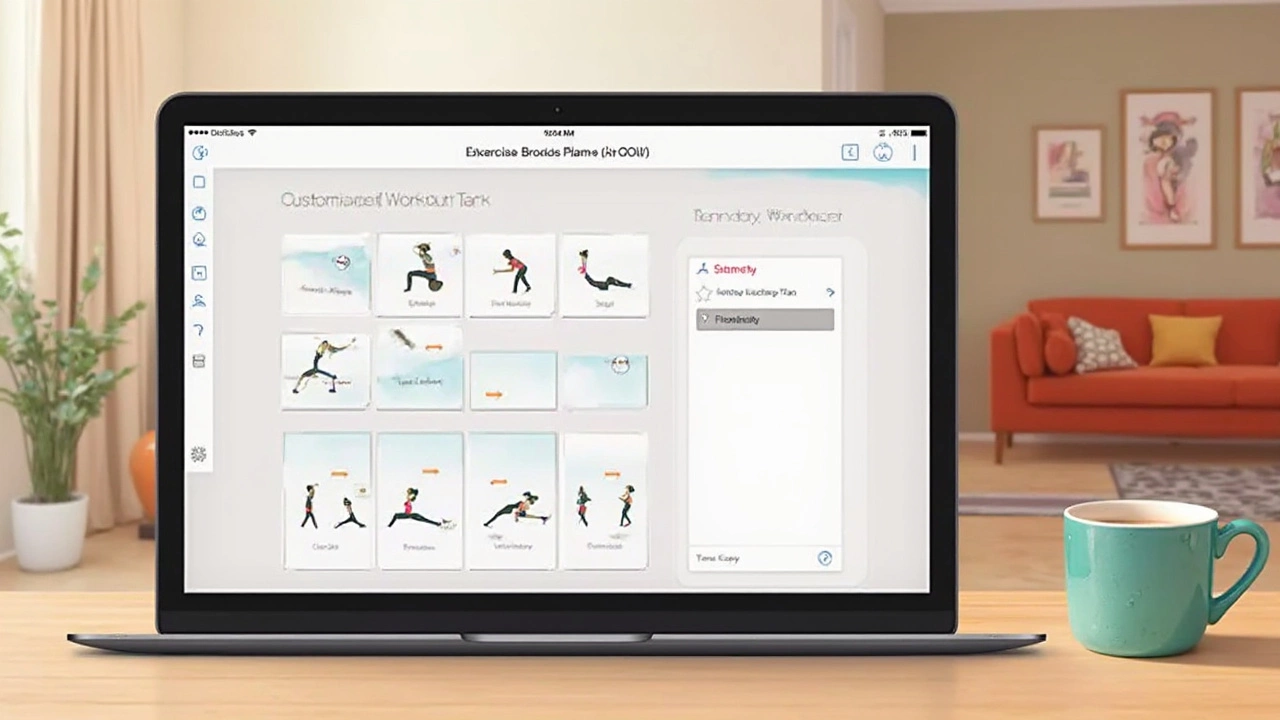How to Create a Gym Plan That Works for You

Alright, so you've decided it's time to hit the gym, but where do you start? Creating a workout plan might seem like a big task, but breaking it down into smaller steps makes it manageable. Setting clear fitness goals is the first step. Whether you want to build muscle, lose weight, or just get moving, having specific, attainable targets gives you direction and motivation.
Next, it's about understanding what you need to do to reach those goals. Different exercises work for different people, and it’s super important to find what's right for you. Cardio, for instance, is great for heart health and burning calories, while strength training helps in building muscle and toning. It's all about balance and knowing what your body needs.
Once you've got an idea of your goals and exercises, you can craft a weekly gym schedule. Consistency is key, so aim for a plan you can stick to. Incorporate a mix of workouts to keep things interesting and ensure you're covering all the bases without getting bored.
- Set Your Fitness Goals
- Understand Different Exercises
- Crafting a Weekly Schedule
- Incorporating Rest Days
- Staying Flexible and Adapting
Set Your Fitness Goals
Figuring out your fitness goals is like setting the GPS before a road trip. Without a destination, you’ll end up driving aimlessly, and in the case of fitness, you could easily lose motivation. Before hitting the gym, take a moment to think about what you really want to achieve. Is it weight loss, muscle gain, endurance improvement, or perhaps just staying active?
Experts often recommend what's called the SMART method for goal setting. This means your goals should be Specific, Measurable, Achievable, Relevant, and Time-bound. Instead of just saying, "I want to build strength," try setting a goal like, "I want to be able to deadlift 100 pounds by the end of three months." This way, you have a clear target and a timeline to work with.
Interestingly, workout goals can be as varied as people themselves. According to the American Council on Exercise, aligning your goals with personal values can actually boost your chances of sticking with a plan. Dr. Pete McCall from ACE says,
“When setting fitness goals, consider why they matter to you personally. Goals that resonate with your core values last longer.”
To make things more actionable, try these steps:
- Reflect: Why do you want to exercise? Write down the core reason.
- Visualize: Imagine how you'll feel once you've achieved your goals.
- Write Your Goal: Use the SMART method to give it structure.
- Share: Tell a friend or family member your intentions to keep yourself accountable.
By the way, did you know there’s a 42% higher chance of reaching your goals if you write them down? This small hack not only clarifies what you want but also pushes you to take action.
Having a clear fitness plan is your gym pass to a healthier, stronger you. So, start jotting down those goals—it’s the first step to making them real!
Understand Different Exercises
When setting up your gym plan, understanding the variety of exercises available and how they align with your goals is key. You don't have to be a fitness expert to sort it out, but a little knowledge goes a long way. Most exercises can be grouped into a few main categories, each serving a different purpose.
First, there's cardio. It's one of the most popular exercise types because it's great for burning calories and improving heart health. Think running on a treadmill, cycling, or even dancing. The goal here is to get your heart rate up, and it's especially useful if your workout goal involves weight loss or general fitness.
Next, let's talk about strength training. This section includes exercises like weight lifting, resistance band workouts, or even bodyweight movements like push-ups and squats. These exercises are all about building muscle and increasing strength. They're crucial if you're aiming for muscle gain or bettering your muscle tone.
Beyond that, there's flexibility and balance exercises. These might not be what you first think of when someone says "gym," but they're important all the same. Yoga and pilates are excellent options here, and they can help in preventing injuries while improving your posture and overall agility.
Don't forget about core exercises, either. A strong core supports your entire body and improves your performance in other activities. Planks, sit-ups, and Russian twists are effective core workouts you can include in your routine.
Here's a simple breakdown of how these exercises can fit into your workout strategy:
- Cardio: 3-5 sessions per week, 20-60 minutes each
- Strength Training: 2-4 sessions per week, targeting different muscle groups
- Flexibility Exercises: Include in cool-down or specific sessions 2-3 times a week
- Core Workouts: Add to the end of strength sessions or on alternate days
Understanding these types of exercises and how to combine them will not only help you meet your fitness goals but keep things interesting. No one wants to do the same thing in every gym session. Mixing it up keeps you motivated and works different muscle groups effectively.

Crafting a Weekly Schedule
So, you're ready to put together a gym plan that fits into your life like your favorite pair of jeans. Great! The trick to a successful weekly schedule is balance and flexibility. You don’t want to overdo it, but you also need enough consistency to see progress.
First, be realistic about the time you can commit. Are you aiming for daily sessions, or is three to four times a week more your speed? It’s crucial to be honest with yourself here to avoid burnout and ensure sustainability.
Here’s a simple approach to structuring your week:
- Day 1: Strength Training (Upper Body) - Focus on your arms, chest, and back. Exercises could include bench presses, rows, and bicep curls.
- Day 2: Cardio - Keep your heart pumping with activities like running, cycling, or a dance class.
- Day 3: Rest or Active Recovery - This can be a gentle yoga session or a casual walk. Let your muscles recuperate.
- Day 4: Strength Training (Lower Body) - Give attention to legs and glutes with squats, lunges, and deadlifts.
- Day 5: Mixed Cardio and Strength - Combine resistance exercises with bursts of high-intensity cardio.
- Day 6: Flexibility and Balance - Practice stretches or balance drills to enhance full-body flexibility.
- Day 7: Rest - Enjoy a well-deserved break!
Don't forget to track your progress. It can be super satisfying to see how far you’ve come in a few weeks. Logs or fitness apps can be handy for this purpose. Plus, always listen to your body. If something doesn’t feel right, take a step back and consult a professional if needed.
By crafting a schedule that respects your time and energy levels, you’ll be more likely to stick with it. And, who knows? Your newfound consistency just might lead to crushing those fitness goals!
Incorporating Rest Days
You may not realize it, but rest days are just as important as your workout days when it comes to any effective gym plan. Why? Because your muscles actually grow and repair during rest, not while you're lifting weights or sweating it out on the treadmill.
Think of rest days as a crucial part of your overall fitness strategy. Skipping these can lead to overtraining, which is basically your body’s way of saying, “Slow down!” Overtraining can cause fatigue, injury, and even regression in your progress, which nobody wants.
So, how do you do rest days right? Here's a simple checklist to help:
- Plan for at least one to two rest days per week. Adapt based on how your body feels.
- Rest days don't mean you have to be completely inactive. Consider 'active rest' activities like walking, yoga, or light stretching.
- Listen to your body – if you're sore or exhausted, it's a solid signal to take it easy.
| Benefit | Description |
|---|---|
| Muscle Repair | Allows your muscles to repair and grow stronger. |
| Mental Recovery | Helps to keep your motivation levels high. |
| Injury Prevention | Reduces the risk of injuries due to overuse. |
Also, it's a good idea to pay attention to what you fuel your body with on rest days. Maintain a balanced diet with enough protein to support muscle recovery and proper hydration to aid the recovery process.
Remember, incorporating rest days isn't about losing momentum; it's about optimizing your fitness journey and ensuring you’re always at your best when you hit the gym again.

Staying Flexible and Adapting
Okay, so you've got your gym plan set, you're hitting your workouts, but what happens when life throws a curveball? It's all about staying flexible. Missing a workout isn’t the end of the world, but learning how to adapt ensures you stay on track with your fitness goals.
First off, listen to your body. If you're feeling fatigued or under the weather, it's okay to skip a session. Rest is just as crucial as exercise and helps prevent burnout and injuries. That said, don’t let a skipped workout turn into a week off. Make it a priority to get back on track.
Secondly, be open to tweaking your routine. Maybe your initial plan included five days a week of exercise, but you're only managing three. That’s totally fine! Adjusting your workout frequency or modifying exercises can make a big difference in keeping your plan realistic and effective.
When it comes to adapting, remember variety is your friend. If you’re losing interest or reaching a plateau, switch things up. Try new classes, adjust your intensity, or mix in different activities. This keeps your workouts exciting and your body guessing, which helps in achieving balanced fitness progress.
Here’s a quick list of ideas for adapting your gym plan:
- Shorten your workout but increase intensity.
- Switch from machines to free weights or vice versa.
- Add in alternative activities like swimming or cycling.
- Experiment with different times of the day for exercising.
Lastly, measure your progress to see what's working and what isn't. A great way to do this is by keeping a simple log of your exercises and noting improvements. According to a study noted in the International Journal of Behavioral Nutrition and Physical Activity, tracking progress can significantly boost motivation.
